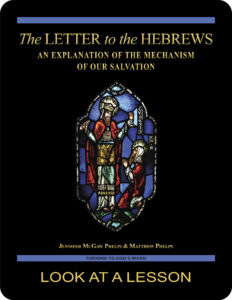 The Letter to the Hebrews:
The Letter to the Hebrews:
An Explanation of the Mechanism
of Our Salvation
Lesson 1 Superior to Angels
the Letter to the Hebrews 1:1–14
Revised Standard Version Catholic Edition (RSVCE)*
New American Bible Revised Edition (NABRE)*
Catechism of the Catholic Church
ex libris (in our library)
Aperuit Illis (Instituting the Sunday of the Word of God)
Redemptor Hominus (Redeemer of Man)
Tami Palladino’s visual-meditation journal
cross references in the Letter to the Hebrews
next lesson: Like His Brethren in Every Respect
This material coordinates with Lesson 1 on pages 4–9 in The Letter to the Hebrews: An Explanation of the Mechanism of Our Salvation.
“In the days of his flesh, Jesus offered up prayers and supplications with loud cries and tears, to him who was able to save him from death, and he was heard for his godly fear. Although he was a Son, he learned obedience through what he suffered; and being made perfect he became the source of eternal salvation to all who obey him, being designated by God a high priest according to the order of Melchizedek.”—the Letter to the Hebrews 5:7–10
welcome to our in-depth study of the Letter to the Hebrews
We invite you to check out the sample first lesson and video from this 18-lesson  Turning to God’s Word Catholic Bible study. Our online study pages link to free
Turning to God’s Word Catholic Bible study. Our online study pages link to free  lesson videos and cross references in the biblical text, and include illustrations and prayers based on Scripture in each lesson. The Letter to the Hebrews: An Explanation of the Mechanism of Our Salvation has been granted an imprimatur. This study currently is being expanded; the content will be available in a new printed study at a later date. Please contact us if you’re interested in purchasing a digital copy of the existing study.
lesson videos and cross references in the biblical text, and include illustrations and prayers based on Scripture in each lesson. The Letter to the Hebrews: An Explanation of the Mechanism of Our Salvation has been granted an imprimatur. This study currently is being expanded; the content will be available in a new printed study at a later date. Please contact us if you’re interested in purchasing a digital copy of the existing study.
every Turning to God’s Word Bible study carries an imprimatur
 The Letter to the Hebrews: An Explanation of the Mechanism of Our Salvation was granted an imprimatur by
The Letter to the Hebrews: An Explanation of the Mechanism of Our Salvation was granted an imprimatur by  the Most Reverend Richard E. Pates, (left), bishop emeritus of the Diocese of Des Moines, on September 14, 2014; the censor librorum for the Diocese of Des Moines, the Very Reverend Aquinas Nichols, granted the nihil obstat. These are official declarations that a book or pamphlet is free of
the Most Reverend Richard E. Pates, (left), bishop emeritus of the Diocese of Des Moines, on September 14, 2014; the censor librorum for the Diocese of Des Moines, the Very Reverend Aquinas Nichols, granted the nihil obstat. These are official declarations that a book or pamphlet is free of  doctrinal or moral error. There’s no implication that those who’ve granted the imprimatur or nihil obstat agree with the contents, opinions, or statements expressed in the work. All Turning to God’s Word Catholic Bible studies are submitted to the Church before publication. Visit the archives of Lost in Translation to read more about the Latin terms imprimatur & nihil obstat. Turning to God’s Word Catholic Bible studies written after 2020 are being submitted to the Most Reverend William M. Joensen, Ph.D. (right), bishop of the Diocese of Des Moines.
doctrinal or moral error. There’s no implication that those who’ve granted the imprimatur or nihil obstat agree with the contents, opinions, or statements expressed in the work. All Turning to God’s Word Catholic Bible studies are submitted to the Church before publication. Visit the archives of Lost in Translation to read more about the Latin terms imprimatur & nihil obstat. Turning to God’s Word Catholic Bible studies written after 2020 are being submitted to the Most Reverend William M. Joensen, Ph.D. (right), bishop of the Diocese of Des Moines.
the popes inspire us—serious Catholics study the Word of God
In his apostolic letter Aperuit Illis (Instituting the Sunday of the Word of God) issued motu proprio (of his  own accord), Pope Francis established the Third Sunday in Ordinary Time to be devoted to the celebration, study, and dissemination of the Word of God. The Holy Father’s apostolic letter was published on September 30, 2019, the feast of St. Jerome and the 1600th anniversary of the saint’s death. St. Jerome, who translated the Latin
own accord), Pope Francis established the Third Sunday in Ordinary Time to be devoted to the celebration, study, and dissemination of the Word of God. The Holy Father’s apostolic letter was published on September 30, 2019, the feast of St. Jerome and the 1600th anniversary of the saint’s death. St. Jerome, who translated the Latin 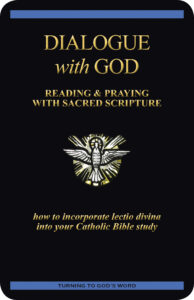 Vulgate Bible from Greek and Hebrew manuscripts, is famous for saying: “Ignorance of Scripture is ignorance of Christ.” In Aperuit Illis, the Holy Father calls attention to the sacramental nature of the Word of God, pointing to the unbreakable bond between Sacred Scripture and the Eucharist. In 2025, the Church will celebrate the Word of God on Sunday, January 26. We’ve posted a free digital version of Dialogue with God: Reading & Praying with Sacred Scripture, our guide to incorporating the Church’s traditional practice of lectio divina (sacred reading) into regular Bible study.
Vulgate Bible from Greek and Hebrew manuscripts, is famous for saying: “Ignorance of Scripture is ignorance of Christ.” In Aperuit Illis, the Holy Father calls attention to the sacramental nature of the Word of God, pointing to the unbreakable bond between Sacred Scripture and the Eucharist. In 2025, the Church will celebrate the Word of God on Sunday, January 26. We’ve posted a free digital version of Dialogue with God: Reading & Praying with Sacred Scripture, our guide to incorporating the Church’s traditional practice of lectio divina (sacred reading) into regular Bible study.
ex libris—read more Church documents
Find links to magisterial documents referred to in Turning to God’s Word Catholic Bible  studies, including Aperuit Illis (Instituting the Sunday of the Word of God), at ex libris—magisterial documents. The page lists significant recent encyclicals as well as a number of historical Church documents.
studies, including Aperuit Illis (Instituting the Sunday of the Word of God), at ex libris—magisterial documents. The page lists significant recent encyclicals as well as a number of historical Church documents.
a few reminders about Turning to God’s Word Bible studies
The most distinguishing feature of our Bible studies is that they’re Catholic. Each one has been granted an imprimatur, which means that a bishop has read the work and found nothing contrary to Church teaching on morals or faith. Note that the imprimatur makes no claim that a work is equivalent to Church teaching, simply that it isn’t opposed to what the Church teaches. Practically speaking, this means that you don’t have to accept Turning to God’s Word interpretations of Scripture, only that choosing to do so doesn’t amount to heresy. Choosing not to accept conclusions of a work that’s been granted an imprimatur doesn’t immediately plunge you into heretical territory, but choosing not to accept Church teaching related to those conclusions does.
read the Catechism—how to avoid heresy
The imprimatur reinforces and validates the claim that Turning to God’s Word Bible studies are Catholic. All participants have a right to expect that discussions about our Bible studies will focus on Catholic teaching. That doesn’t mean that someone won’t occasionally have a question about Church teaching. Not knowing what the Church teaches about a particular issue isn’t heretical. Asking a question about Church teaching isn’t heretical. Failing to understand Church teaching isn’t heretical. Insisting that Church teaching is wrong is.
 Most people who begin to study the Letter to the Hebrews are caught off guard by how many challenging theological ideas are found in Scripture. There are a surprising number of things many Catholics believe to be Church teaching that actually are not. In this study, we attempt to present Scripture and Church teaching related to the Letter to the Hebrews as unambiguously as possible. When in doubt, you can refer to the Catechism of the Catholic Church or talk with your parish priest about any doctrine that remains unclear.
Most people who begin to study the Letter to the Hebrews are caught off guard by how many challenging theological ideas are found in Scripture. There are a surprising number of things many Catholics believe to be Church teaching that actually are not. In this study, we attempt to present Scripture and Church teaching related to the Letter to the Hebrews as unambiguously as possible. When in doubt, you can refer to the Catechism of the Catholic Church or talk with your parish priest about any doctrine that remains unclear.
If a Church teaching seems particularly unsettling even after studying the Catechism and speaking with someone who’s knowledgeable regarding Catholic doctrine, you might want to examine whether there might be a personal or emotional reason why you’re having difficulty. Pray for God’s guidance and be open to receiving a different answer than you anticipated, possibly at a later time than you expected or hoped.
be respectful of the others in your group
Keep in mind that most people in your discussion group are there for a Catholic interpretation of Scripture. People from other faith backgrounds are welcome, but the focus of any Turning to God’s Word study always is going to be Catholic in nature. The following opening prayer emphasizes maintaining mutual respect amid differences of opinion:
Heavenly Father, send forth your Spirit to enlighten our minds
and dispose our hearts to accept your truth.
Help us to listen to one another with openness and honesty,
eager to learn from the talents and intuitions that you have given each of us.
Never let differences of opinion diminish our mutual esteem and love.
May we leave this meeting with more knowledge and love for you and your Son.
In the unity of the Holy Spirit. Amen.
You can find other opening prayers on our website. We especially like the following:
Lord Jesus, you promised to send your Holy Spirit to teach us all things.
As we read and study your word today,
allow it to touch our hearts and change our lives. Amen.
WHAT DO YOU THINK about interpreting Scripture?
 The Church encourages Catholics to read and interpret Scripture on our own as long as we follow these two rules:
The Church encourages Catholics to read and interpret Scripture on our own as long as we follow these two rules:
1) Our interpretation can’t contradict anything else in Scripture.
2) Our interpretation can’t contradict Church teaching.
In order to comply, we need to know everything else that’s in the Bible as well as everything that the Church teaches. That’s a tall order, which is why each Turning to God’s Word Catholic Bible study is submitted to the Church for an imprimatur. The imprimatur for The Letter to the Hebrews: An Explanation of the Mechanism of Our Salvation is a guarantee that the Church finds nothing objectionable in the work. You’re free to agree with interpretations in The Letter to the Hebrews: An Explanation of the Mechanism of Our Salvation, but it’s not essential that you do so. There are many different interpretations in other commentaries, but very few of them carry an imprimatur. This doesn’t mean that they necessarily pose any problems in regard to Catholic doctrine or moral teaching, but there’s no Church guarantee that they don’t.
When considering opinions that haven’t been granted an imprimatur, don’t be afraid to ask questions. Our Bible studies address some common interpretations, but there are innumerable opinions floating around about the meaning of different passages in the Bible—including in the Letter to the Hebrews.
 ? Here’s the first question to ask about an opinion expressed in any commentary: How closely does it adhere to what we can read in the biblical text?
? Here’s the first question to ask about an opinion expressed in any commentary: How closely does it adhere to what we can read in the biblical text?
? Do viewpoints about the meaning of the Bible passages contradict anything else you already know from Scripture?
? Do they contradict anything from Church teaching? The Catechism of the Catholic Church addresses a large number of questions related to common Scripture interpretations.
 an unusual beginning for a letter (07:56)
an unusual beginning for a letter (07:56)
In the video for this lesson, Turning to God’s Word author Matthew Phelps  discusses the opening of the Letter to the Hebrews, including how little it resembles introductions to most letters. From the author’s reference to “our Father” in his abrupt beginning, we learn that he regards himself as related to his audience by common ancestry. As forms of communication go, God’s direct communication trumps all others, including the Letter to the Hebrews. While God previously communicated through the prophets, that now has changed. This spiritual change that’s taken place will be the focus of the Letter to the Hebrews,
discusses the opening of the Letter to the Hebrews, including how little it resembles introductions to most letters. From the author’s reference to “our Father” in his abrupt beginning, we learn that he regards himself as related to his audience by common ancestry. As forms of communication go, God’s direct communication trumps all others, including the Letter to the Hebrews. While God previously communicated through the prophets, that now has changed. This spiritual change that’s taken place will be the focus of the Letter to the Hebrews,  and it’s come about through God’s own Son. This study and its videos are undergoing revision to incorporate additional material. The original content will be included in a different printed study. The original 18 lessons pertaining to the Letter to the Hebrews currently are available digitally.
and it’s come about through God’s own Son. This study and its videos are undergoing revision to incorporate additional material. The original content will be included in a different printed study. The original 18 lessons pertaining to the Letter to the Hebrews currently are available digitally.
what to expect from this Bible study
While all Christians believe that we’re saved through the Passion, death, and Resurrection of Jesus 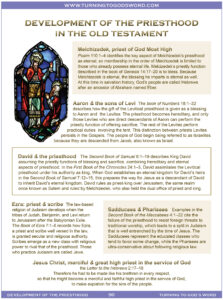 Christ, few of us can explain how this process of salvation works. It’s relatively easy to understand that Jesus is able to rise from the dead—though exactly how he does this is a mystery. It’s not at all obvious how Jesus’ Resurrection opens the possibility of eternal life for all men and women. This is the question that the author of the Letter to the Hebrews sets about answering. To do this, he examines the Old Testament to learn the basic spiritual laws governing how salvation works. It’s those spiritual laws that we’ll be studying in The Letter to the Hebrews: An Explanation of the Mechanism of Our Salvation. We’ll also be looking at the scriptural underpinnings of the priesthood, beginning with the first priest mentioned in the Old Testament and ending with the priesthood of Jesus Christ. An overview of the development of the priesthood (right) can be found on the back page of The Letter to the Hebrews: An Explanation of the Mechanism of Our Salvation. Click on the image to enlarge it. Content in the original Lessons 19 through
Christ, few of us can explain how this process of salvation works. It’s relatively easy to understand that Jesus is able to rise from the dead—though exactly how he does this is a mystery. It’s not at all obvious how Jesus’ Resurrection opens the possibility of eternal life for all men and women. This is the question that the author of the Letter to the Hebrews sets about answering. To do this, he examines the Old Testament to learn the basic spiritual laws governing how salvation works. It’s those spiritual laws that we’ll be studying in The Letter to the Hebrews: An Explanation of the Mechanism of Our Salvation. We’ll also be looking at the scriptural underpinnings of the priesthood, beginning with the first priest mentioned in the Old Testament and ending with the priesthood of Jesus Christ. An overview of the development of the priesthood (right) can be found on the back page of The Letter to the Hebrews: An Explanation of the Mechanism of Our Salvation. Click on the image to enlarge it. Content in the original Lessons 19 through  23 that focused on the scriptural basis of the priesthood has been moved to other Turning to God’s Word Catholic Bible studies, especially You Shall Have No Other Gods: The Book of Exodus.
23 that focused on the scriptural basis of the priesthood has been moved to other Turning to God’s Word Catholic Bible studies, especially You Shall Have No Other Gods: The Book of Exodus.
WHAT DO YOU THINK about your relationship to time?
In the Letter to the Hebrews 1:2, the author seems to be emphasizing an aspect of Creation that we usually don’t think about—that God’s Son not only was a necessary presence in the Creation of all material things, he also created “the ages.” This means the constructs of time and space that limit the actions of humanity are part of God’s Creation. While humanity is restricted to operating within the confines of time and space, God’s Son has power over temporal and spatial matters. The Turning to God’s Word in-depth Catholic Bible study The Revelation of Jesus Christ: The Faithful Witness describes a New Testament apocalyptic vision in which time and space disappear at the Final Judgment.
God’s Word in-depth Catholic Bible study The Revelation of Jesus Christ: The Faithful Witness describes a New Testament apocalyptic vision in which time and space disappear at the Final Judgment.
? How would you describe the relationship between God the Creator and his Creation?
? What is humanity’s relationship to time?
? How might the relationship between God’s Son and “the ages” play a key role in the salvation of humanity?
? Consider whether your own relationship to time is collaborative or adversarial.
? For what purpose do you think God gave humanity the gift of time?
? What is one thing you can do today to make better use of this gift?
 the popes inspire us—God has spoken
the popes inspire us—God has spoken
Take a few minutes to read “God Has Spoken” on page 9 in The Letter to the Hebrews: An Explanation of the Mechanism of Our Salvation. This magisterial quote is taken from Redemptor Hominus (Redeemer of Man). In it, Pope St. John Paul II examines the mysterious way in which God chose to speak to humanity by entering history as a human person and becoming a divine actor in that history. You can find links to other magisterial documents referred to in Turning to God’s Word Catholic Bible studies at ex libris—magisterial documents.
who are the angels?
In order to begin to understand the ways in which Jesus Christ is superior to the angels, we need knowledge of who the angels are and the purpose for which they were created. “Angel” on page 6 in The Letter to the Hebrews: An Explanation of the Mechanism of Our Salvation sheds light on the role played by the angels. “How God Communicates” on page 9 examines the differences between the angels and the Son of God in even more detail, focusing on Jesus Christ’s significance as the intermediary or meeting point between God and humanity.
 seraphim—you could look it up in our archives
seraphim—you could look it up in our archives
Most of us know that seraphim are angels with six wings. To learn more about the fascinating linguistic connection between seraphim and serpents, which has far-reaching implications, read Lost in Translation, an online column in which Turning to God’s Word author Matthew Phelps helps readers connect with ideas expressed in the original languages of the Scriptures. New Lost in Translation entries are posted on Mondays, and past entries are archived on our website. Contact us if you’d like to receive Lost in Translation by email every week.
start at the beginning
An understanding of Creation and the problem to humanity posed by original sin is foundational to any Bible study. It’s no surprise that the author of the Letter to the Hebrews chooses to open with an explanation that the universe was created through God’s Son and is upheld by his word of power. The first chapter in the Letter to the Hebrews assumes that readers are familiar with humanity’s need for salvation. Instead of rehashing the basics about how that need came about, the author of the Letter to the Hebrews immediately begins developing his explanation for how it is that Jesus (who isn’t yet mentioned by name) is able to bring about the possibility of salvation for all men and women. Part of that explanation rests on the superiority of the Son of God, which appears to be tied to his necessary presence at Creation. Learn more about the two Creation stories in the Old Testament in  Lesson 1 And God Said, Let There Be Light and Lesson 2 It Is Not Good That the Man Should Be Alone, both in the Turning to God’s Word Catholic Bible study In the Beginning: The Book of Genesis.
Lesson 1 And God Said, Let There Be Light and Lesson 2 It Is Not Good That the Man Should Be Alone, both in the Turning to God’s Word Catholic Bible study In the Beginning: The Book of Genesis.
another video—one that could change the way you approach the Bible (40:44)
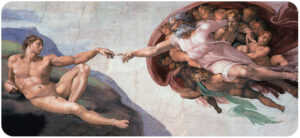 Even if you’re a veteran of Catholic Bible studies, we encourage you to watch an explanation of the practical benefits of approaching The Bible as the Living Word of God. This 40-minute video is distilled from a talk that Turning to God’s Word author Matthew Phelps gave at a summer Bible study retreat at Conception Abbey in Conception, Missouri. In this video, Matthew looks at how viewing Scripture as a living document can help us to develop a more intimate relationship with Jesus Christ. There are benefits in setting aside what we think we know about Scripture to approach the Bible with the goal of learning what new things God is saying to us. Matthew examines the principles of lectio divina, the traditional Catholic approach to reading and praying with Scripture that’s foundational for all Turning to God’s Word Bible studies.
Even if you’re a veteran of Catholic Bible studies, we encourage you to watch an explanation of the practical benefits of approaching The Bible as the Living Word of God. This 40-minute video is distilled from a talk that Turning to God’s Word author Matthew Phelps gave at a summer Bible study retreat at Conception Abbey in Conception, Missouri. In this video, Matthew looks at how viewing Scripture as a living document can help us to develop a more intimate relationship with Jesus Christ. There are benefits in setting aside what we think we know about Scripture to approach the Bible with the goal of learning what new things God is saying to us. Matthew examines the principles of lectio divina, the traditional Catholic approach to reading and praying with Scripture that’s foundational for all Turning to God’s Word Bible studies.
visual lectio divina paired with this Bible study
Don’t miss Turning to God’s Word co-founder Tami Palladino’s illustrated reflections on Scripture passages 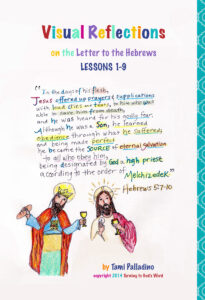
 from The Letter to the Hebrews: An Explanation of the Mechanism of Our Salvation. Click on the drawing (left) to open Tami’s sketchbook and obtain access to her reflections for this lesson. Tami also illustrated Sing a New Psalm: Communicating with God Through the Prayers of the Church—Volume I: Lauds & Vespers and The Revelation of Jesus Christ: The Faithful Witness, as well as some lessons in In the Beginning: The Book of Genesis and in You Shall Have No Other Gods: The Book of Exodus.
from The Letter to the Hebrews: An Explanation of the Mechanism of Our Salvation. Click on the drawing (left) to open Tami’s sketchbook and obtain access to her reflections for this lesson. Tami also illustrated Sing a New Psalm: Communicating with God Through the Prayers of the Church—Volume I: Lauds & Vespers and The Revelation of Jesus Christ: The Faithful Witness, as well as some lessons in In the Beginning: The Book of Genesis and in You Shall Have No Other Gods: The Book of Exodus.
Q&A—where to find some answers
Some people are used to doing Bible studies from other publishers, and they’ve told us that they miss the answer keys in those studies. One leader even admitted that she relied on answer keys so she didn’t have to spend time doing Bible study lessons herself. We sympathize with omnipresent time constraints, but we maintain that up-front answer keys provide people with a strong temptation to rely on someone else’s idea of what Scripture means instead of thinking more deeply about what God might be trying to say to each of us as individuals at a particular moment in time.
 Q: Why don’t Turning to God’s Word Catholic Bible studies provide any printed answer keys?
Q: Why don’t Turning to God’s Word Catholic Bible studies provide any printed answer keys?
A: The Turning to God’s Word method of Bible study is dependent on participants directly engaging with the biblical text and looking to that text for answers to their questions. All of the factual questions in the lessons can be answered from the Scriptures. Sidebars in the lessons contain supplemental material written to help explain some of the themes suggested by the biblical text. Most of our studies, including this one, feature videos with each lesson.
Outside commentaries can shed light on individual texts, but many commentaries examine Scripture passages out of context. Some may focus on an academic rather than a spiritual approach to the Bible. If you’re confused about anything in our studies or in any related outside commentaries, we encourage you to browse our website for more information.
The goal of all Turning to God’s Word Catholic Bible studies is to foster personal reflection leading to a more intimate relationship with Jesus. Consequently, each lesson contains  reflection questions, and these necessarily don’t have any “right” or “wrong” answers. If you’d like to share your thoughts about any of our studies or need clarification about a question, commentary, or video related to the lessons, contact us using the “ask us your question” or “what do you think” button on any online lesson page. Because others may have the same concern, we routinely turn questions and comments we receive into anonymous Q&A items and add them to the relevant online study pages.
reflection questions, and these necessarily don’t have any “right” or “wrong” answers. If you’d like to share your thoughts about any of our studies or need clarification about a question, commentary, or video related to the lessons, contact us using the “ask us your question” or “what do you think” button on any online lesson page. Because others may have the same concern, we routinely turn questions and comments we receive into anonymous Q&A items and add them to the relevant online study pages.
Q&A—three questions about Bible translations
We’re frequently asked what translation of the Bible is best. Sometimes we’re asked which translation is approved to be read at Catholic Masses. More infrequently we’re asked why we’ve chosen to reprint the Revised Standard Version Second Catholic Edition (RSV2CE) for the biblical text in our printed studies.
Q1: Which translation of the Bible is the best one for Catholics to read? 
A2: As far as which translation is best, we maintain that reading any translation of the Bible you have on hand is a great place to start. The old adage “every translator is a traitor” certainly applies to Scripture, but God’s basic message to his people can be found in any Bible. While there are English-language Bibles catering to a variety of special-interest Catholic groups, they generally reprint either a translation of the New American Bible Revised Edition (the NABRE) or a Catholic edition of the Revised Standard Version (the RSVCE or the RSV2CE), which are the Bibles read by most American Catholics. Both of these translations rely on archeological finds and scholarship that were unavailable in earlier centuries. Before the mid-1960s, many Catholics were familiar with the Douay-Rheims English translation, which was based on the Latin Vulgate. Originally translated by St. Jerome in the late 4th century, a version of the Vulgate has remained the official Latin translation of the Catholic Church since the 16th century. Before the mid-1960s, most Protestants read The King James Version.
As people become more interested in Scripture study, they also become more interested in reading the “right” Bible. Since very few of us are proficient in ancient languages, we’re forced to rely on the work of scholars who’ve spent years studying Hebrew, Greek, Aramaic, and Latin. In many cases, there simply isn’t an easy way to translate some of the original words and phrases of Scripture into English. The best advice we can offer is to choose an English translation that the Church has approved. The United States Conference of Catholic  Bishops (USCCB) offers guidelines. When questions arise, as they undoubtedly will, check out footnotes, commentaries, and other translations; talk to a knowledgeable priest; and—this part is most important—ask God to grant you increased understanding. You also can email us with your questions about Scripture. In many cases, Turning to God’s Word author Matthew Phelps’ background in classical languages proves helpful. We frequently rely on him to shed some light on the linguistics involved in difficult passages.
Bishops (USCCB) offers guidelines. When questions arise, as they undoubtedly will, check out footnotes, commentaries, and other translations; talk to a knowledgeable priest; and—this part is most important—ask God to grant you increased understanding. You also can email us with your questions about Scripture. In many cases, Turning to God’s Word author Matthew Phelps’ background in classical languages proves helpful. We frequently rely on him to shed some light on the linguistics involved in difficult passages.
 Q2: I’m having trouble locating the same Bible that I hear read at Mass. What translation is that?
Q2: I’m having trouble locating the same Bible that I hear read at Mass. What translation is that?
A2: The Catholic Lectionary, a collection of biblical texts approved for liturgical use, isn’t the same as a Bible. The English-language lectionary used in the United States is primarily based on a 1970 translation. A close English translation outside the lectionary is the New American Bible Revised Edition (NABRE). The United States Conference of Catholic Bishops (USCCB) currently is working on a liturgical Bible based on the NABRE translation.
 Q3: Why has Turning to God’s Word chosen to reprint biblical text from the Revised Standard Version Second Catholic Edition (RSV2CE) instead of the New American Bible Revised Edition (NABRE)?
Q3: Why has Turning to God’s Word chosen to reprint biblical text from the Revised Standard Version Second Catholic Edition (RSV2CE) instead of the New American Bible Revised Edition (NABRE)?
A3: We currently use the Revised Standard Version Second Catholic Edition (RSV2CE) as our primary biblical translation in our printed studies because scholars consider it to be a more faithful word-for-word translation than many other translations. Pope Benedict XVI quotes from the RSV2CE in his three-volume book, Jesus of Nazareth. The RSVCE is the Bible translation used in English translations of the Catechism of the Catholic Church. The RSV2CE varies only slightly from the earlier RSVCE, which we link to on our online study pages. Any discrepancies between the RSV2CE and the RSVCE are pointed out on the online study pages. Turning to God’s Word cites The Abbey Psalms and Canticles in references to the Psalms in all of our printed studies.
pray with the Psalms—intensely emotional prayers
Although some scholars question David’s authorship of the Psalms, it remains indisputable that many of the Psalms address  themes related to events that occurred during the period when David ruled over the descendants of Jacob. Reading and praying with the Psalms offers insight into the minds and hearts of people who lived during the time of David—and long afterward as well. These prayers express universal human feelings every bit as relevant to us in the present day as when the Psalms first were composed.
themes related to events that occurred during the period when David ruled over the descendants of Jacob. Reading and praying with the Psalms offers insight into the minds and hearts of people who lived during the time of David—and long afterward as well. These prayers express universal human feelings every bit as relevant to us in the present day as when the Psalms first were composed.
don’t get confused—Psalms numbering varies
Numbering of many of the Psalms verses varies from one translation to another. Parallel numbering for commonly used Catholic Bibles is noted in the citations index included in the sample lesson for this study of the Letter to the Hebrews. For more information about why the numbering varies in some translations, see the online Q&A on the study page for Lesson 1 Set a Guard on My Mouth in the Turning to God’s Word Catholic Bible study Sing a New Psalm: Communicating with God Through the Prayers of the Church—Volume I: Lauds & Vespers.
numbering for commonly used Catholic Bibles is noted in the citations index included in the sample lesson for this study of the Letter to the Hebrews. For more information about why the numbering varies in some translations, see the online Q&A on the study page for Lesson 1 Set a Guard on My Mouth in the Turning to God’s Word Catholic Bible study Sing a New Psalm: Communicating with God Through the Prayers of the Church—Volume I: Lauds & Vespers.
the best Catholic commentary about Scripture
 To find out more about how Church teaching is supported by Scripture passages in The Letter to the Hebrews: An Explanation of the Mechanism of Our Salvation, check out the Index of Citations in the Catechism of the Catholic Church. Links to the primary Scripture passages in the lesson (Revised Standard Version Catholic Edition [RSVCE*]) and relevant paragraphs in the Catechism are provided here. Not every passage in the biblical text for this study is referenced in a Catechism paragraph, however.
To find out more about how Church teaching is supported by Scripture passages in The Letter to the Hebrews: An Explanation of the Mechanism of Our Salvation, check out the Index of Citations in the Catechism of the Catholic Church. Links to the primary Scripture passages in the lesson (Revised Standard Version Catholic Edition [RSVCE*]) and relevant paragraphs in the Catechism are provided here. Not every passage in the biblical text for this study is referenced in a Catechism paragraph, however.
the Letter to the Hebrews 1:1–2—paragraph 65
the Letter to the Hebrews 1:1–3—paragraph 102
the Letter to the Hebrews 1:3—paragraphs 241, 320, 2502, 2777, 2795
the Letter to the Hebrews 1:6—paragraph 333
the Letter to the Hebrews 1:13—paragraph 447
the Letter to the Hebrews 1:14—paragraph 331
to learn more, read more Scripture
If you’re having difficulty with a particular passage of Scripture, it can be helpful to read the relevant  cross references—but looking these up can take time. To make that easier, we’ve compiled the cross references from the Revised Standard Version Second Catholic Edition (RSV2CE)—the translation that we reprint in our study books. That list can be found at the top of every online study page, and it includes links to cross references in the primary biblical text for The Letter to the Hebrews: An Explanation of the Mechanism of Our Salvation.
cross references—but looking these up can take time. To make that easier, we’ve compiled the cross references from the Revised Standard Version Second Catholic Edition (RSV2CE)—the translation that we reprint in our study books. That list can be found at the top of every online study page, and it includes links to cross references in the primary biblical text for The Letter to the Hebrews: An Explanation of the Mechanism of Our Salvation.
don’t forget about our indexes & extra online material

 If you’re trying to locate information about a passage in Scripture, you can look it up in the index in the online sample lesson. If you want to revisit a particular commentary, you can look that up by title in the topics index. If you want to learn more about another book of the Bible for which there’s a Turning to God’s Word study, you can read the online commentaries and watch any accompanying videos by going to the online study directories. Finally, if you have a question or would like to make a comment about any of our studies, you can use one of the “ask us your question” or “what do you think” buttons to email our authors.
If you’re trying to locate information about a passage in Scripture, you can look it up in the index in the online sample lesson. If you want to revisit a particular commentary, you can look that up by title in the topics index. If you want to learn more about another book of the Bible for which there’s a Turning to God’s Word study, you can read the online commentaries and watch any accompanying videos by going to the online study directories. Finally, if you have a question or would like to make a comment about any of our studies, you can use one of the “ask us your question” or “what do you think” buttons to email our authors.
ex libris—Church documents & books about religious topics
Link to magisterial documents referred to in our Bible studies at ex libris—magisterial documents.  This listing includes significant recent encyclicals as well as a number of historical Church documents. Recommended books related to Scripture study can be found at ex libris—main bookshelf.
This listing includes significant recent encyclicals as well as a number of historical Church documents. Recommended books related to Scripture study can be found at ex libris—main bookshelf.
memorize a favorite Bible verse (4:46)
Turning to God’s Word co-founder Tami Palladino has created a short video about the benefits of memorizing Bible verses. Choosing a passage that you find particularly meaningful will make the task easier. There are inspiring verses in every book of the Bible, but some people in our Turning to God’s Word Catholic Bible studies like to memorize a verse from their lesson every week. For more ideas, check out Tami’s video, Why Memorize Scripture? It’s less than five minutes long.
wondering how to pronounce some of these words?
The following link is to a reading from the New International Version (NIV) Bible. To listen, open the link and click on the audio icon above the printed text. Although not taken from the translations used in our study materials, the NIV reading provides an audio guide to pronunciation of words in this lesson’s primary biblical text. A close online version of the translation of the Bible used in Catholic liturgy in the United States as well as an audio guide for daily Mass readings for the current month can be found on the website of the United States Conference of Catholic Bishops (USCCB).
the Letter to the Hebrews 1:1–14 (NIV)
 close with Bible-based prayer related to this lesson
close with Bible-based prayer related to this lesson
Many of our Catholic study groups like to conclude their discussions with a prayer based on the scriptural focus of their lesson, and some participants include Scripture-specific prayer in their individual study. If you’re uncomfortable composing your own Bible-based prayers you can follow our four easy steps, or you can use the following prayer based on this lesson’s text from the Letter to the Hebrews.
God of all ages,
in the past you spoke through the prophets.
Teach us to listen to your Son that we might obtain salvation
through him whom you appointed the heir of all things.
We ask this in the name of Jesus Christ, who is superior to the angels. Amen.
Lesson 2 Like His Brethren in Every Respect—the Letter to the Hebrews 2:1–18
you also may like our study of the book of Genesis
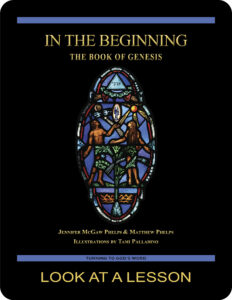 The first seven lessons of In the Beginning: The Book of Genesis, a 28-lesson Catholic Bible study with an imprimatur, provide an in-depth look at the very earliest biblical history—including the two accounts of Creation, events surrounding the Fall of Adam and Eve, the relationship between Cain and Abel, and the baptismal foreshadowing present in the account of Noah and the Flood. Remaining lessons look at lives of the patriarchs Abraham, Isaac, Jacob, and Joseph. Click on the book’s cover to view a sample lesson.
The first seven lessons of In the Beginning: The Book of Genesis, a 28-lesson Catholic Bible study with an imprimatur, provide an in-depth look at the very earliest biblical history—including the two accounts of Creation, events surrounding the Fall of Adam and Eve, the relationship between Cain and Abel, and the baptismal foreshadowing present in the account of Noah and the Flood. Remaining lessons look at lives of the patriarchs Abraham, Isaac, Jacob, and Joseph. Click on the book’s cover to view a sample lesson.
start a Turning to God’s Word Bible study
Thank you for your interest in The Letter to the Hebrews: An Explanation of the Mechanism of Our Salvation.  Information about beginning a Turning to God’s Word Bible study can be found at start a Bible study. Tami, Matthew, and I are available to answer your questions and to offer support. Contact us if you’re interested in purchasing a digital version of this study, in starting another Turning to God study, or in having your study schedule listed with other TtGW study groups on our website. —Jennifer
Information about beginning a Turning to God’s Word Bible study can be found at start a Bible study. Tami, Matthew, and I are available to answer your questions and to offer support. Contact us if you’re interested in purchasing a digital version of this study, in starting another Turning to God study, or in having your study schedule listed with other TtGW study groups on our website. —Jennifer
*There are seven deuterocanonical books in the Old Testament—the Books of Tobit, Judith, Wisdom, Sirach, Baruch, and First and Second Maccabees, as well as some passages in the Books of Esther and Daniel. Protestants usually refer to these works as “apocryphal,” a word that means “outside the (Protestant) canon” because they’re excluded from most Protestant Bibles. The word “deuterocanonical” means “second canon”; Catholics use that word to refer to any section of the Catholic Old Testament for which there are no extant, or existing, Hebrew manuscripts. All of the deuterocanonical books appear in the Septuagint, the earliest remaining versions of which date to the 1st century B.C. This Greek translation of the Old Testament was in common use by Jews at the time of Jesus. Learn more by reading How Do Catholic & Protestant Bibles Differ?
Turning to God’s Word printed Bible studies use the 2006 Revised Standard Version Second Catholic Edition (RSV2CE) translation for all Scripture references except those to the Psalms, which are taken from The Abbey Psalms and Canticles, prepared by the Benedictine monks of Conception Abbey and published in 2020 by the United States Conference of Catholic Bishops (USCCB). All Scripture links for the online pages of The Letter to the Hebrews: An Explanation of the Mechanism of Our Salvation are to the 1966 Revised Standard Version Catholic Edition (RSVCE) translation. The New International Version (NIV) audio recordings follow the same chapter and verse numbering as the RSV Catholic translations, but the NIV translation doesn’t include the deuterocanonical books and passages.
The 1966 RSVCE uses archaic pronouns and verb forms such as “thee,” “thou,” “didst” in the Psalms and in direct quotations attributed to God. The 2006 RSV2CE replaces these with more accessible English. The few significant translation changes in the RSV2CE include rendering almah as “virgin” in the Book of Isaiah 7:14 and restoring the term “begotten” in the Gospel According to John 3:16.
Numbering varies for some passages in this Bible study. Turning to God’s Word studies (print and digital) follow the numbering in the Revised Standard Version Catholic translations (RSV2CE and RSVCE). Discrepancies in the New American Bible Revised Edition (NABRE) are noted in the Index of Scripture Citations in the study book and the online sample.
 You can learn more about the Psalms by viewing a sample lesson from the Turning to God’s Word Catholic Bible study Sing a New Psalm: Communicating with God Through the Prayers of the Church—Volume I: Lauds & Vespers. The second part of that study, Sing a New Psalm: Communicating with God Through the Prayers of the Church—Volume II: Vigils, Day Prayer & Compline, is scheduled for publication in 2025. Some verse numbers may vary in different translations of the Psalms..
You can learn more about the Psalms by viewing a sample lesson from the Turning to God’s Word Catholic Bible study Sing a New Psalm: Communicating with God Through the Prayers of the Church—Volume I: Lauds & Vespers. The second part of that study, Sing a New Psalm: Communicating with God Through the Prayers of the Church—Volume II: Vigils, Day Prayer & Compline, is scheduled for publication in 2025. Some verse numbers may vary in different translations of the Psalms..
